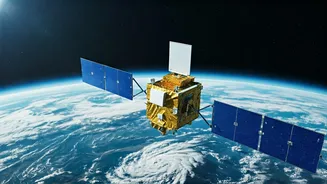Etna's Eruption Puzzle
Mount Etna, one of the world's most active volcanoes, has always presented a challenge to scientists in terms of predicting its eruptions. The conventional
methods, which include monitoring seismic activity, gas emissions, and ground deformation, have sometimes been insufficient for providing adequate warning. The complexity of the volcanic system, coupled with the unpredictable nature of subterranean processes, has made it hard to anticipate when the volcano would erupt. Previous prediction models often missed critical precursors, resulting in delayed alerts or false alarms. The goal has been to find more robust indicators that can provide earlier and more reliable warning signals to protect local populations and infrastructure surrounding the volcano. The need to understand the underlying mechanisms that trigger eruptions has driven researchers to seek novel approaches to improve prediction accuracy.
New Earthquake Pattern Analysis
A team of researchers has developed a new approach that focuses on analyzing earthquake patterns preceding eruptions. This methodology is based on the idea that pre-eruptive activity often generates specific seismic signatures. It involves advanced data processing techniques and sophisticated algorithms to identify unique patterns in seismic data. The team collected extensive data sets from past eruption events at Mount Etna. These data sets were then processed to detect the precursory signals that might indicate an impending eruption. These patterns would be subtle, requiring advanced computational methods. This new method aims to identify subtle changes in earthquake characteristics, such as frequency, amplitude, and temporal distribution, which might be indicative of the volcano preparing to erupt. The goal is to provide earlier and more reliable warnings for communities near active volcanoes.
Earlier Warning Signals
The main benefit of this approach is its ability to identify the warning signals earlier than the conventional methods. The new model identifies subtle changes in earthquake patterns. These changes can then be correlated with the onset of an eruption, thus providing an early warning. The earlier warnings can be crucial. This extended lead time gives authorities and residents additional time to prepare for an eruption. With the improved warnings, mitigation measures can be implemented. For instance, evacuation plans can be executed more efficiently, reducing the potential impact on human lives and infrastructure. The ability to forecast eruptions with greater accuracy also helps reduce the incidence of false alarms. By improving the predictive capability of the system, this reduces the disruption of daily life and enables more effective resource allocation during periods of volcanic unrest.
Future Implications & Research
This research has broad implications beyond Mount Etna. The approach could be applied to other active volcanoes worldwide, potentially saving lives and minimizing damage. However, more extensive research is needed to validate and refine the method. The team plans to incorporate additional data sources, such as gas emissions and ground deformation data, to create a comprehensive model. These enhancements will involve using machine learning algorithms. The ultimate goal is to create a fully integrated monitoring system. This system will combine different data streams to provide a more holistic assessment of volcanic activity. This may allow scientists to better understand the complex processes that lead to eruptions. Continued research into this earthquake pattern analysis is a significant step toward enhanced volcanic hazard assessment and public safety.











